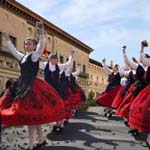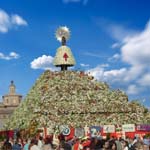Fiestas del Pilar
The Fiestas del Pilar are one of the most popular and busy religious celebrations in Spain, and depict the idiosyncrasy of the people of Aragon as no other festivity. They also coincide with Spain's National Day, which only contributes more to the celebration's frenzy.
Origin
The Fiestas del Pilar started taking place in Saragossa somewhere in the XVIII century. At first, the celebration revolved around religion-oriented events like masses, sermons, processions and popular rosary recitals, although other activities also took place, such as bullfights and the Giants and Big-Heads parade –which existence is reported as far back as 1659-. The first documented celebration of the Fiestas took place from October 12th to 20th, 1723, and included a popular parade, mojigangas (human towers), passacaglia, and a big bullfight, which was the basic scheme for the celebration until the end of the XIX century.

In 1873, a new element was introduced in the festivities: a grand parade that went through Saragossa’s streets up to the city’s bullring. Another important event happened in 1894, when the first Jota contest (a typical dance of the region) was held, and since then has been a constant in the Fiestas del Pilar. The next big change came long after the Spanish Civil War, around 1958, when two of the most important aspects of the celebration as we enjoy it today were added: the Offering of Flowers and the Offering of Fruits.
CelebrationEvents
Even though the street celebrations start some days earlier, the main events of the Fiestas del Pilar take place on the 12th and the 13th of October. The whole thing starts on the 12th at around 4:30 am, when the Solemn Mass of Infants takes place in one of the chapels of the Basilica of Our Lady of El Pilar. This is a huge event, attended by many worshipers, and marks the start of the celebrations.

After the mass, also on the 12th of October, the Offering of Flowerstakes place. This is probably the single most multitudinous event of the Pilar Feast, consists in placing flowers on a huge ramp structure created for the purpose, on top of which the image of the Virgin Mary is displayed. There is a parade going around downtown before the offering itself takes place, in which more that 500,000 people, dressed in the typical costumes from Aragon and other regions of Spain, bring flowers and chant and dance typical songs. The event starts at 7:30 in the morning, and goes on until around 5 in the afternoon.
On the 13th, at midday, takes places another offering, the Offering of Fruits, where the best fruits from that years’ harvest are presented to the Virgin Mary by the different regional fraternities. After the offering, which has a symbolic intention, the fruits are distributed amongst the charity kitchens of the city in an act of solidarity.
Another central event of the religious celebration is the so-called Glass Rosary, a procession that takes place on the evening of the 13th around the main streets of Saragossa’s downtown. The procession is a personification of the Rosary, each of its beads portrayed by a small chariot, illuminated from the inside, popularly called lanterns. The lanterns are made of glass, and represent the different mysteries, as well as other imagery, and because they are built out of that material –glass- the whole procession was given the name of the Glass Rosary.
Aside from these events, also some other activities take place around town: the Speech –which inaugurates the celebration- given by a local celebrity, the Giants and Big-Heads parade, the General Fair –a gastronomic event attended by no less than 250,000 people-, the Beer Fest –a reflection of Munich’s Oktoberfest-, a bullfighting festival –the last of the bullfighting season in Spain-, fireworks, concerts, theatre plays –both in the streets and at the city’s theatre venues-, and even a circus comes into town to complete the program of one of the most popular, participative, diverse and colourful celebration taking place in Spain.

 The Virgin of El Pilar attracts a lot of devotees and is the main star of a celebration that turns the ancient city of Saragossa upside-down!
The Virgin of El Pilar attracts a lot of devotees and is the main star of a celebration that turns the ancient city of Saragossa upside-down! 